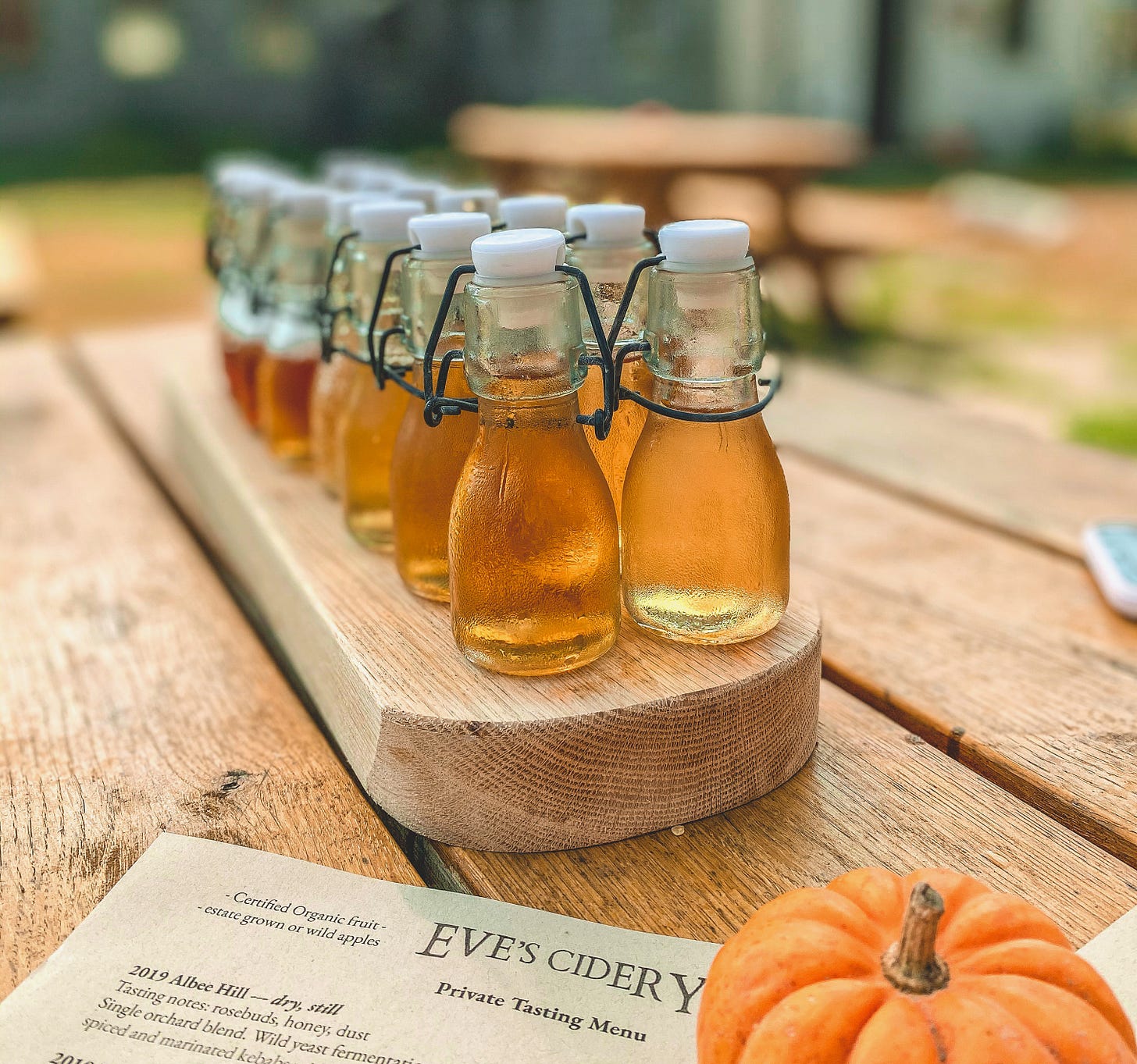Paid subscribers, your contribution lets me pay writers a much better-than-average rate. Thank you! (If you haven’t yet supported Smart Mouth and its writers, please subscribe here).
More Food Reading:

Two great essays that gave me a wide range of feelings on the nostalgia-amused-aching pain spectrum:
A Cider-Based Road Trip With Tiny Sips
By: Bridget Shirvell
As soon as the airs gets even a hint of crispness in the Northeast, locals start to think about cider. Not the plastic-jug juice, but the alcoholic beverage, crafted like wine, that tastes to us like fall in a glass. But despite cider’s rising popularity, getting that actual glass can be a challenge unless you happen to live close to a taproom or are up for a road trip. In which case, take a drive to the Finger Lakes, walk the orchards, taste the cider and stock up on a bottle or 12.
South Hill Cider
Start just outside of downtown Ithaca at South Hill Cider. Every fall, the cider makers there forage for wild apples in hedgerows and forests around the Finger Lakes, using them along with the heirloom apple varieties grown at their orchard to craft crisp, juicy, earthy ciders.
Finger Lakes Cider House
Whether you prefer your cider dry, sweet or are still figuring it out, Finger Lakes Cider House at Good Life Farm has something for you in its wide variety of choices. Opt for a cider flight and work your way through the varieties. Afterward, walk the fields of the working organic farm and say hello to the turkeys. You can even spend the night at their onsite yurt.
Eve’s Cidery
Can you taste a place? Autumn Stoscheck and her cider partners, husband Ezra Sherman and farmer James Cummins, hope the answer is yes. They manage thousands of trees at several orchards in and around the hamlet of Van Etten. You’ll need a reservation and a bit of perseverance for Eve’s. It’s tricky to find, even with GPS, but worth the wrong turn or two. Cross the bridge over Cayuta Creek in Van Etten and pull into the cidery on the left, settle into a seat on the patio and let the lovely people behind this magical place guide you through a tasting.
Redbyrd
Lively bubbles, plenty of acidity, maybe even a touch of nuttiness: you’ll find complex ciders made in a variety of methods at the certified biodynamic Redbyrd Orchard Cider. Husband and wife team Eric Shatt and Deva Mass use apples from their orchards in the region and foraged fruit, some from wild seedling trees they propagate in their orchards. Tastings are by appointment only, or pick up a bottle from them at the Trumansburg Farmers’ Market. 🍎
A Road Trip Favorite Started in an Arizona Pharmacy
By Eric Bryan
Pulling into an A&W on a road trip often isn’t a premeditated choice: more likely, a glimpse of the restaurant’s oval, earth-toned sign triggered an exit from the freeway. Famed mostly for its root beer, (though it also serves milkshakes, a whole burger “family,” French fries and onion rings), A&W is perhaps the first successful American food franchise, and is the country’s first and longest-running restaurant chain.
In Arizona on business in 1918, Roy Allen ran into a pharmacist who’d perfected a root beer formulation. Allen bought the recipe and opened a root beer stand in Lodi, California a year later, giving away glasses of root beer on the first day. The following day he started charging a nickel for a 10-ounce draft.
In 1922 Allen went into partnership with Frank Wright, founding A&W Root Beer. Using a carnival wagon, Allen established a drive-up A&W Root Beer stand in Sacramento in 1923. Allen bought out Wright in 1924, and in 1925 started selling A&W franchises. The root beer was the main menu item, with various foods included at the discretion of the franchisees. By 1950 there were approximately 450 A&W Root Beer stands.
The drive-in concept worked brilliantly: In 1957 there were about 1400 A&Ws in the US and Canada; by 1960 more than 2000 A&W restaurants were operating.
In the early 1960s, A&W introduced (and perhaps even created) the bacon cheeseburger and developed its “Burger Family:” the Papa, Mama, Teen, and Baby. The number of A&W restaurants in the US peaked in 1967 at 2400, a figure greater than the number of McDonald’s outlets at the time.
In the 1970s A&W opened sit-down restaurants fitted with salad bars. But by the mid-’80s A&W was struggling, reduced to 500 franchises. (It’s now back up to over 600, most of them dotting the freeways of the U.S.)
A&W says it still makes its root beer using berries, bark, spices, herbs, and cane sugar. But the exact recipe that Allen bought remains a company secret. 🍻
Vegetarian huarache at Farmer and the Cook in Ojai, CA. Every element perfection. Way better than it has any business being, given that you order in the back of a grocery store.
If you enjoy the newsletter today, please forward it to someone who’d enjoy it, and tap the heart icon above or below, which will help me reach more readers. I appreciate your help, y’all!
This newsletter is edited by Katherine Spiers, host of the podcast Smart Mouth.
A TableCakes Production.
Want to contribute? Here are the submission guidelines.








Starting to get really excited about cider this season... great read!